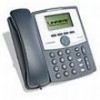Linksys SPA922 Cisco SPA9000 Voice System Web-UI Based Product Installation an - Page 97
Configuring Inbound Call Routing, Routing Calls to the Auto Attendant (Default)
 |
UPC - 745883570836
View all Linksys SPA922 manuals
Add to My Manuals
Save this manual to your list of manuals |
Page 97 highlights
Configuring Phone Service and Voice Mail Configuring Inbound Call Routing 5 Configuring Inbound Call Routing Inbound call routing defines how external incoming calls are handled and routed by the SPA9000 Voice System. You can configure the following options to handle the incoming calls: • Step "Routing Calls to the Auto Attendant (Default)," on page 95 • "Routing Calls to a Receptionist, Extension, or Hunt Group," on page 96 Routing Calls to the Auto Attendant (Default) By default, all incoming calls are routed to the Auto Attendant, where users are prompted to enter the extension number of the destination phone. STEP 1 Start Internet Explorer, and then enter the IP address of the SPA9000. Click Admin Login and then click Advanced. STEP 2 Click Voice tab > Line 1. STEP 3 In the Contact List field, enter: aa STEP 4 Repeat steps 3-4 for all active lines. STEP 5 Adjust the Day Time Answer Delay: a. Click Voice tab > SIP, and scroll down to the Auto Attendant Parameters section. b. In the Daytime Answer Delay field, enter the number of seconds that the Auto Attendant will wait before answering a call. The default value is 12 seconds. SPA9000 Voice System Installation and Configuration Guide for Web UI 95















